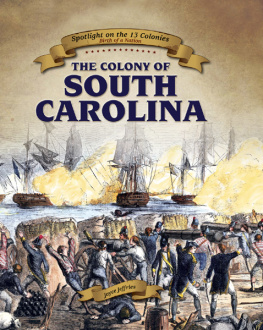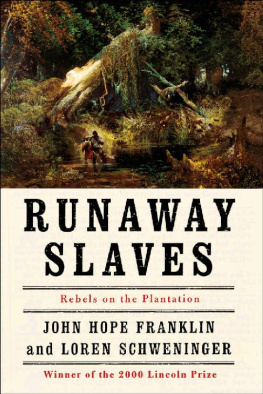STUDIES IN AFRICAN AMERICAN HISTORY AND CULTURE
edited by
GRAHAM HODGES
C OLGATE U NIVERSITY
Lathan Algerna Windley (ca. 1970)
A PROFILE OF RUNAWAY SLAVES IN VIRGINIA AND SOUTH CAROLINA FROM 1730 THROUGH 1787
LATHAN ALGERNA WINDLEY
Copyright 1995 Flossie Windley All rights reserved
First published by Garland Publishing, Inc.
This edition published 2013 by Routledge
Routledge
Taylor & Francis Group
711 Third Avenue
New York
NY 10017
Routledge
Taylor & Francis Group
2 Park Square
Milton Park, Abingdon
Oxon OX14 4RN
Routledge is an imprint of the Taylor & Francis Group, an informa business
Library of Congress Cataloging-in-Publication Data
Windley, Lathan A.
A profile of runaway slaves in Virginia and South Carolina from 1730 through 1787 / Lathan Algerna Windley.
p. cm. (Studies in African American history and culture)
Includes bibliographical references (p. ) and index.
ISBN 0-8153-1018-8 (acid-free paper)
1. Fugitive slavesVirginiaHistory18th century. 2. Fugitive slavesSouth CarolinaHistory18th century. 3. VirginiaRace relations. 4. South CarolinaRace relations. I. Title. II. Series.
E445.V8W593 | 95-32389 |
973.26dc20 | CIP |
Contents
This writer would like to extend his appreciation to the many individuals who aided him in the completion of this study.
This thesis was written under the direction of Dr. Sydney V. James, to whom I am indebted for his scholarly guidance, patience, and advice during the course of this investigation. His thoughtfulness and understanding will always be appreciated.
I also wish to extend my appreciation to members of the Department of History of the University of Iowa who voluntarily assisted in this study. Particular thanks is extended to Dr. John C. James, Dr. Alan B. Spitzer and Dr. Malcolm J. Rohrbough.
I am especially grateful to Mrs. Barbara Davis, Mrs. Louise Levine, and other staff personnel who programmed and processed my data through the University of Iowa Computer Center; to Special Support Service, for providing funds for research travel; to the Graduate College for funding my computer project; and to the personnel of the various University of Iowa Libraries for their assistance. Additionally, my appreciation is extended to the University of Kansas, Duke University, University of Delaware, University of Virginia, University of Texas, University of Georgia, West Virginia University, University of North Carolina, East Carolina University, University of California (Berkeley), Wisconsin Historical Society, and the Charleston Library Society for providing newspapers and other manuscripts used in this study.
Finally, the writer wishes to thank his parents, Mr. and Mrs. Clifton Windley, Sr. for their support; his wife, Flossie, for the many hours she spent coding data, for typing the text, and for making many sacrifices on my behalf throughout the course of this study; and, his children, Rodney and Monica, for their patience and understanding during the time of this investigation. To them, this thesis is dedicated.
Lathan Algerna Windleys study, A Profile of Runaway Slaves in Virginia and South Carolina from 1730 through 1787, has informed and influenced dozens of scholars of slavery and African American culture. Over the years, scholars have mined this work and Windleys four volume collection, Runaway Slave Advertisements: A Documentary History from the 1730s to 1790, published by Greenwood Press in 1983. Windleys interpretation of runaway slave advertisements offered a two-pronged approach. In the first chapter, he presents a very complete discussion of the legal mechanics of slave control; subsequent chapters chart slave appearance, personality, destinations and degrees of acculturation. Windleys text skillfully weaves examples from over 3600 slaves to argue that southern slavery was more open than closed. Diverging from Stanley Elkinss influential work, which teaches that slaves were permanently transformed and limited by slavery, Windleys use of slave advertisements demonstrates that slaves lived multifaceted lives and were able to sustain autonomous cultures. His heavy use of tables bolsters his arguments. Appearing in this edition in an , Windleys tables chronicle the ages, heights, appearances, occupations and cultural interests of slaves in addition to their methods of disguise, items taken with them and destinations. All of these subjects are now staples of slave scholarship, but Windleys study was among the first to quantify them.
Lathan Algerna Windley was Associate Professor of History at Morgan State University in Baltimore, Maryland. He taught at Morgan State from 1963 until his death in 1982 and was widely revered as a scholar, teacher, and colleague. Windley received his B.A and M.A. degrees from North Carolina Central University and earned the Ph.D. in history from the University of Iowa in 1974. He is survived by his wife Flossie and children, Rodney and Monica.
Generally this edition replicates Professor Windleys work. It was necessary, as noted, to place tables in an . I created the index.
Graham Russell Hodges
Hamilton, New York, 1995.
Although historians have investigated various aspects of the institution of slavery, the subjects of the runaway slave and the legal controls which governed him have been afforded little or no investigation. Whenever the fugitive has been mentioned, it has been too brief, in general terms and not related in any way to the legal network which existed to control him. This omission by some historians has no doubt influenced their conclusions in favor of the notion that slaves accepted permanent bondage with few efforts to free themselves. Included among such historians are Ulrich B. Phillips and Stanley Elkins. Phillips characterized slaves as follows: for the most part [they] were by racial quality submissive rather than defiant, light-hearted instead of gloomy, amiable and ingratiating instead of sullen, and [their] very defects invited paternalism rather than repression.1 In another work, Phillips reiterates the point: In the main the American Negroes ruled not even themselves. They were more or less contentedly slaves, with grievances from time to time but not ambition.2 Thus, Phillips paints a picture of contentment among slaves and acceptance of their slavery. Stanley Elkins pictured the slave in much the same fashion as Phillips, but went even further to characterize him as a helpless child, much dependent upon his master for survival. He stated it thus: His relationship with his master was one of utter dependence and childlike attachment; it was indeed this childlike quality that was the very key to his being.3
Phillips viewed absconding lightly, not so much as a protest against slavery but more as a form of truancy.4 Elkins overlooked the matter altogether. These historians have presented a distorted picture of slaves. They would have us believe that slaves did nothing to rid themselves from the shackles of bondage. Obviously had these historians given some attention to the runaway and the laws for the prevention, apprehension and treatment of runaways, their conclusions about slavery might well have been quite different.











